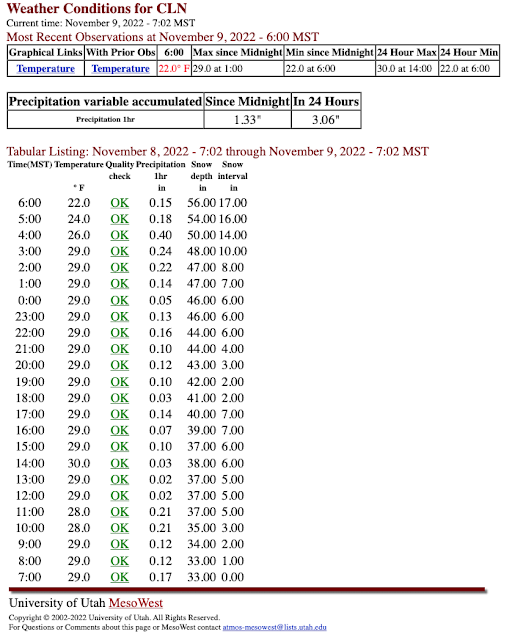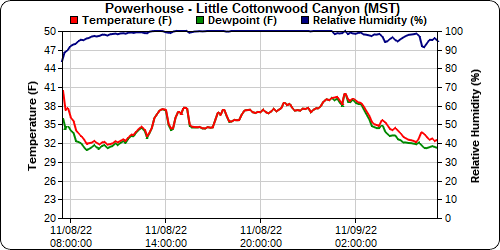Mother Nature is serving appetizers this morning before the main course tonight and tomorrow in the form that I can only describe as an Early November Storm of Our Dreams.
The surface cold front moved into the Salt Lake Valley last night, passing over the University of Utah at about 0530 MST this morning and producing a rapid drop in temperature. Temperatures have subsequently fallen into the high 30s.
As of 1441 UTC (0741 MST) this morning the front was very near Point of the Mountain with north winds and temps near 40 in Bluffdale and Draper, but southerly flow and temps near 50 around Point of the Mountain and Saratoga Springs. Crest-level winds in the central Wasatch remain southerly or southwesterly on Hidden Peak, Mt. Baldy, Cardiff Peak, and Reynolds Peak. The front has not arrived in the central Wasatch, so snow levels remain high. It is 32–35˚F at observing sites near the base of Alta for example.
Radar imagery at 1440 UTC (0740 MST) shows scattered precipitation, in some areas heavy (e.g., southeast Salt Lake Valley and western Central Wasatch.
Nearly all of these precipitation features are moving from southwest to northeast as the cold-front is shallow and the primary driver of precipitation processes remains the southwesterly flow aloft.
Observations from Alta-Collins shows fits and starts of precipitation overnight, increasing in intensity after about 0500 MST. In the hour ending at 0700 MST, 0.17" of water equivalent fell, and a total of 0.32" has fallen since midnight. Temperatures at this 9662 ft observing site are mild and are now around 29˚F.
We recently installed a profiling radar system at the Atwater site near the base of Alta. This is a radar that looks up through the storm, rather than scanning horizontally. Overnight, Echoes were first detected aloft at 0400 UTC (2100 MST) and reached the ground at about 0600 UTC (2300 MST). The pulse-like nature of the echoes through 1430 UTC (0730 MST) is consistent with convective showers, which were probably in the form of wet snow and graupel at the observing site and even to upper elevations.
The forecast for today is essentially a WYSIWYG forecast, meaning What You See Is What You Get. The 12Z HRRR for example, stalls the front pretty much near it's current location near Point of the Mountain with northerly flow over the Salt Lake Valley at 2200 UTC (1500 MST), southerly flow near Point of the Mountain, and southerly to south-southwesterly flow over the Central Wasatch.
The HRRR also produces periods of showers in the southwesterly upper level flow, sometimes heavy, in the form of upper elevation snow and lower elevation rain through the day today. The other models are in general agreement with this. If you are skiing today, hard shell recommended as the snow level will be in the 7000-8000 ft range and above that the snow will be wet. Note that thunder and lightning are possible with stronger showers.
Things change overnight. I added time-height sections for the HRRR to weather.utah.edu yesterday [under the HRRR (48 h) tab] so I'll used it here to illustrate what is expected. Overnight, a deeper cold front pushes into the Salt Lake Valley at around 0800 UTC (0100 MST). Ahead of this front, the southerlies intensify so we will see return to southerly flow in the Salt Lake Valley. Additionally, this isn't one of those northwesterly cold surges. The flow behind the front shifts briefly only slightly and the flow aloft gradually veers from southerly to westerly over a several hour period.
However, the models are generally locked in on the front being accompanied by heavy precipitation. The have actually been advertising this for days, although amounts have been variable. The HRRR composite reflectivity and satellite imagery forecast for the time of frontal passage [0800 UTC (0100 MST) tonight] shows the band of heavy precipitation extending from St. George to Salt Lake City.
Precipitation continues overnight in the wake of the front. Although there could be a break during the day tomorrow, convective showers develop in the deep cold air that moves in tomorrow afternoon.
Let's look at some numbers. From 1200 UTC (0500 MST) this morning (Tuesday) through 1200 UTC (0500 MST) Thursday, the HRRR generates 2.09" of water equivalent at Alta-Collins. Given the southwesterly flow, it's even more excited for Sundance, Snowbasin, and Powder Mountain, although those resorts will probably see rain at their bases today. Most of this falls through mid-morning tomorrow (Wednesday).
The GFS numbers are pretty similar. The GFS totals below, however, include precipitation overnight, but at least for Alta-Collins the GFS didn't produce any precipitation overnight, so from 1200 UTC (0500 MST) this morning (Tuesday) through 1200 UTC (0500 MST) Thursday, the GFS is generating 2.4" at that site.
Our GFS-derived guidance product shows very well the situation today with a high wet-bulb zero level (and snow level) today that crashes down overnight when the front moves in. Snow-to-liquid ratios are near 10:1 today but increase to 15"1 overnight. I suspect the former is too high and we will see even higher densities than that.
The 2.46" of water equates to 26.1" of snow based on our algorithms. Most of this falls by 10 am tomorrow with dribs and drabs after that. The increase in snow-to-liquid ratio during the storm indicates that although the average density will be high, it will be a right-side-up storm, although avy danger is likely to be an issue.
My take on this is we are probably going to see storm totals at Alta Collins from last night through Thursday morning in the 2-3" range for water equivalent and 20–30" for snowfall. The lower elevations will suffer today, but get a decent shot once the front comes in tonight. The NWS is even more excited, going for 2.5–3.5" of water (although their 18–32" of snow brackets my 20–30").
 |
| NWS Cottonwood Canyons Forecast screenshot at 8:32 AM 8 November 2022 |
What can I say? This is a dream early November storm for building a seasonal snowpack.




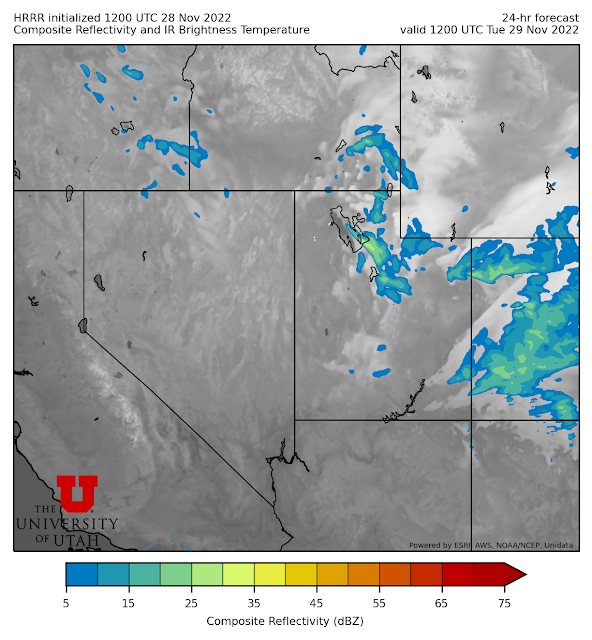






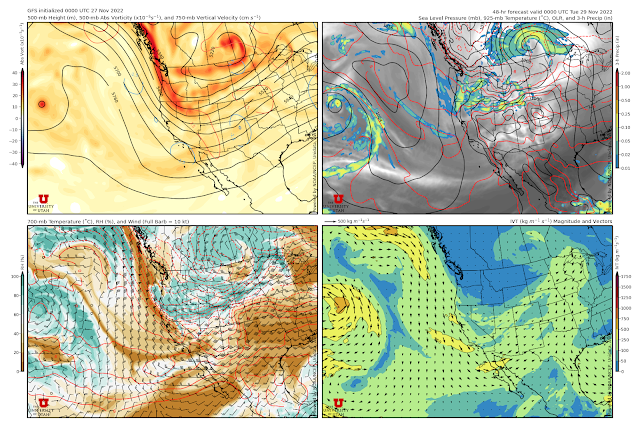





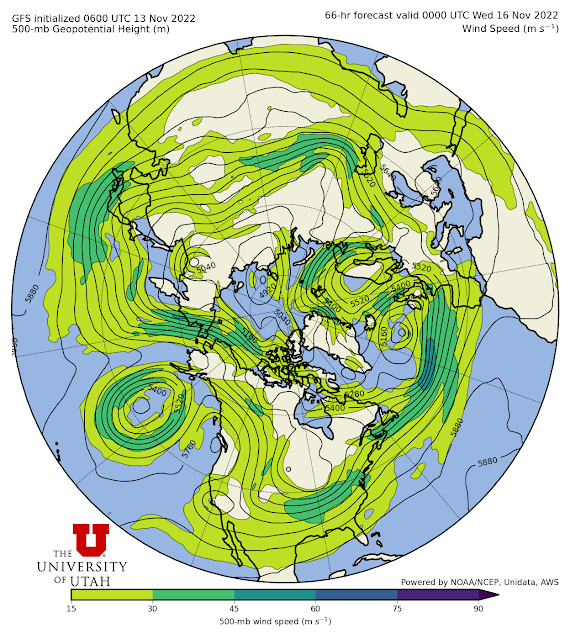
.png)







